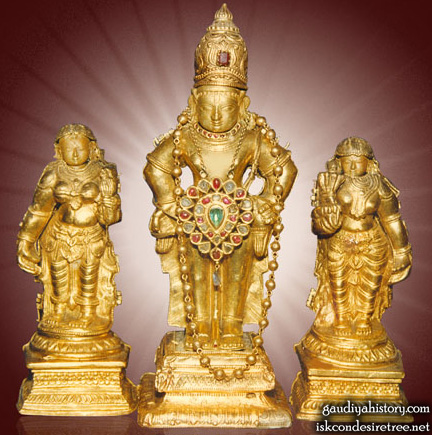Shripad Akshobhya Tirtha was born in 1159 Sakabja Era (1238 AD) and was the last of Madhva's direct disciples to sit on the Vedanta Pitha. He did so from 1350 AD -1365 AD. Previously his name was Govinda Shastri, a former follower of a non-Vaishnava ('advaitin') line before meeting and surrendering to Shrimad Acharya (Shripad Madhvacharya), and who also came from Uttara-Karnataka.

After establishing Akshobhya Tirtha as the head of the Pejawar Mutt Shripad Madhvacharya gave him the Deity of Aja-Vithal. (Krishna standing with His hands of His hips, accompanied by Shri Devi and Bhudevi, though some say this is Krishna with Rukmini and Satyabhama, technically they are the same Persons with His expanded pleasure potencies anyway.)
After establishing Akshobhya Tirtha as the head of the Pejawar Mutt Shripad Madhvacharya gave him the Deity of Aja-Vithal. (Krishna standing with His hands of His hips, accompanied by Shri Devi and Bhudevi, though some say this is Krishna with Rukmini and Satyabhama, technically they are the same Persons with His expanded pleasure potencies anyway.)
It is said that Akshobhya Tirtha was in himself not a distinguished or prolific writer, yet he stands out as an important personage in the history of the Madhva line (BNK Sharma. 1961. History of the Dvaita School of Vedanta. page 229.) It is said by some that he wrote a book called Madhvatattvasaarasamgraha of which nothing is known, yet the name suggests it was a manual of the Dvaita doctrine.
Shri Akshobhya Tirtha who initiated Shri Jaya Tirtha (author of Shriman Nyaya Sudha) was a contemporary of the great 'advaitin' Shri Vidyaranya and of a celebrated 'Visistha-advaitin' scholar Shri Vedanta Deshika. It was this Vidyaranya who established the Vijyanagar Kingdom for the twins Hakka and Bukka, and not the Madhava Tirtha that we know in our sampradaya (C.R. Rao. "Shrimat Uttaradi Mutt"). There is a historic incident which is understood to have taken place at Mulbagal near Kolar, Karnataka. His victim was the same Vidyaranya, the big, big 'mayavadin' scholar and 'guru' descendant of the 'Advaitan' line of Sankara.
In the year 1336 AD., Shri Akshobhya Tirtha had a scholarly disputation with Shri Vidyaranya on the interpretation of the "Tatvam-asi" ("You are the same as" or "I am that") 'Shruthi' text. The extensive and elaborate and sometimes acrimonious arguments were exchanged in the presence of Shri Vedantha Deshika who was chosen by both as an arbitrator. Another tradition says that all the arguments were literally written down and then sent to Shri Vedantha Deshika whose verdict was in favour of Shri Akshobhya Tirtha. The epigraphic evidence of this historic victory is on a commemorative pillar of victory on a hill near Mulubagal that can be seen even today.
This was his main 'claim to fame', the dynamic way he refuted the 'tat tvam asi – 'you are the same as', philosophy of the 'mayavadis'.
Either way the story is told, it is a stated and documented fact that Shripad Akshobhya Tirtha was more than victorious. In fact Shripad Akshobhya Tirtha smashed Vidyaranya so badly that in history this was considered the turning point in the new Madhva faith of 'Dwaitavad'. To this day the philosophy of 'Dwaita' (dualism) has not been defeated; even the 'Adwaitin mayavadis', knowing they are wrong, with stubborn determination, or masochistic glee, like moths flying into the flame of personalistic knowledge, they have yearly been coming back to Udupi to get smashed.

Shripad Akshobhya Tirtha who is believed to be a Rudra-amshi (a partial incarnation of the aspect of Lord Shiva), has his 'vrindavana' (samadhi) on the banks of river Kagini in a place called Malkeda (Karnataka). (In the image: Lord Shiva).
Shripad Akshobhya Tirtha moved after this a little north to Pandharapur on the banks of the Bhima-rathi River, which is where he met his future disciple Jaya Tirtha. In the years to follow Akshobhya Tirtha dedicated most of his time training Jaya Tirtha in 'Dwaita' philosophy. The relationship was so nice that Shripad Akshobhya Tirtha gave his every breath to make Shripad Jaya Tirtha the most proficient and dynamic preacher since Madhva, hence Jaya Tirtha was called the second moon of Madhva and Tikacharya, for his many small commentaries. Shripad Akshobhya Tirtha taught him how to search out hidden significance's in the words of Madhva which others missed, and how to write books on those points called Tikas, which further demolished the hostile 'Advaitin' monism. Empowered by Akshobhya Tirtha he caused such a stir by even pointing out the differences in the basic understandings of 'Advaita' philosophy of their own leading Sankarites like Vachaspati, Vivarankara, Amalananda, Chitsukha and Vijnanashana, giving further strength to the Vaishnavas truths and making the 'mayavadis' all look all the more foolish.
Shripad Akshobhya Tirtha who is believed to be a Rudra-amshi (a partial incarnation of the aspect of Lord Shiva), has his 'vrindavana' (samadhi) on the banks of river Kagini in a place called Malkeda (Karnataka).